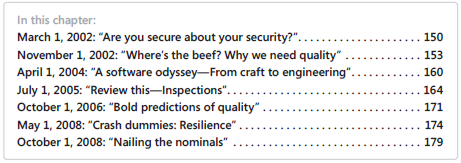New book: I. M. Wright’s “Hard Code”: A Decade of Hard-Won Lessons from Microsoft, Second Edition
 We’re very happen to announce that the second, newly expanded edition of I. M. Wright’s “Hard Code”: A Decade of Hard-Won Lessons from Microsoft, by Eric Brechner is available for purchase. (Print ISBN 9780735661707; Page Count 448).
We’re very happen to announce that the second, newly expanded edition of I. M. Wright’s “Hard Code”: A Decade of Hard-Won Lessons from Microsoft, by Eric Brechner is available for purchase. (Print ISBN 9780735661707; Page Count 448).
Here is an excerpt from Chapter 5, “Software Quality—More Than a Dream”.
Chapter 5
Software Quality—More Than a Dream
Some people mock software development, saying if buildings were built like
software, the first woodpecker would destroy civilization. That’s quite funny, or
disturbing, but regardless it’s misguided. Early buildings lacked foundations. Early
cars broke down incessantly. Early TVs required constant fiddling to work properly.
Software is no different.
At first, Microsoft wrote software for early adopters, people comfortable replacing
PC boards. Back then, time to market won over quality, because early adopters
could work around issues, but they couldn’t slow the clock. Shipping fastest meant
coding quickly and then fixing just enough to make it work.
Now our market is consumers and the enterprise, who value quality over the
hassles of experimentation. The market change was gradual, so Microsoft’s initial
response was simply to fix more bugs. Soon bug fixing was taking longer than
coding, an incredibly slow process. The fastest way to ship high quality is to trap
errors early, coding it right the first time and minimizing rework. Microsoft has
been shifting to this quality upstream approach over the time I’ve been writing
these columns. The first major jolt that drove the company-wide change was a
series of Internet virus attacks in late 2001.
In this chapter, I. M. Wright preaches quality to the engineering masses. The first
column evaluates security issues. The second analyzes why quality is essential and
how you get it. The third column explains an engineering approach to software that
dramatically reduces defects. The fourth talks about design and code inspections.
The fifth describes metrics that can predict quality issues before customers experience them.
The sixth focuses on techniques to make software resilient. And
the chapter aptly finishes by emphasizing the five basics of software quality.
While all these columns provide an interesting perspective, the second one,
“Where’s the beef? Why we need quality” stands out as an important turning point.
When I wrote it few inside or outside Microsoft believed we were serious about
quality. Years later, many of the concepts are taken for granted. It took far more
than an opinion piece to drive that change, but it’s nice to call for action and have
people respond.
May 1, 2008: “Crash dummies: Resilience”
 I heard a remark the other day that seemed stupid on the surface,
I heard a remark the other day that seemed stupid on the surface,
but when I really thought about it I realized it was completely idiotic
and irresponsible. The remark was that it’s better to crash and let
Watson report the error than it is to catch the exception and try to
correct it.
From a technical perspective, there is some sense to the strategy of allowing the crash to
complete and get reported. It’s like the logic behind asserts—the moment you realize you
are in a bad state, capture that state and abort. That way, when you are debugging later
you’ll be as close as possible to the cause of the problem. If you don’t abort immediately, it’s
often impossible to reconstruct the state and identify what went wrong. That’s why asserts
are good, right? So, crashing is sensible, right?
Oh please. Asserts and crashing are so 1990s. If you’re still thinking that way, you need to
shut off your Walkman and join the twenty-first century, unless you write software just for
yourself and your old-school buddies. These days, software isn’t expected to run only until its
programmer got tired. It’s expected to run and keep running. Period.
Struggle against reality
Hold on, an old-school developer, I’ll call him Axl Rose, wants to inject “reality” into the
discussion. “Look,” says Axl, “you can’t just wish bad machine states away, and you can’t fix
every bug no matter how late you party.” You’re right, Axl. While we need to design, test,
and code our products and services to be as error free as possible, there will always be bugs.
What we in the new century have realized is that for many issues it’s not the bugs that are
the problem—it’s how we respond to those bugs that matters.
Axl Rose responds to bugs by capturing data about them in hopes of identifying the cause.
Enlightened engineers respond to bugs by expecting them, logging them, and making their
software resilient to failure. Sure, we still want to fix the bugs we log because failures are
costly to performance and impact the customer experience. However, cars, TVs, and networking
fail all the time. They are just designed to be resilient to those failures so that crashes
are rare.
Perhaps be less assertive
“But asserts are still good, right? Everyone says so,” says Axl. No. Asserts as they are implemented
today are evil. They are evil. I mean it, evil. They cause programs to be fragile instead
of resilient. They perpetuate the mindset that you respond to failure by giving up instead of
rolling back and starting over.
We need to change how asserts act. Instead of aborting, asserts should log problems and
then trigger a recovery. I repeat—keep the asserts, but change how they act. You still want
asserts to detect failures early. What’s even more important is how you respond to those failures,
including the ones that slip through.
If at first you don’t succeed
So, how do you respond appropriately to failure? Well, how do you? I mean, in real life, how
do you respond to failure? Do you give up and walk away? I doubt you made it through the
Microsoft interview process if that was your attitude.
When you experience failure, you start over and try again. Ideally, you take notes about what
went wrong and analyze them to improve, but usually that comes later. In the moment, you
simply dust yourself off and give it another go.
For web services, the approach is called the five Rs—retry, restart, reboot, reimage, and
replace. Let’s break them down:
■ Retry First off, you try the failed action again. Often something just goofed the first
time and will work the second time.
■ Restart If retrying doesn’t work, restarting often does. For services, this often means
rolling back and restarting a transaction or unloading a DLL, reloading it, and performing
the action again the way Internet Information Server (IIS) does.
■ Reboot If restarting doesn’t work, do what a user would do, and reboot the machine.
■ Reimage If rebooting doesn’t work, do what support would do, and reimage the
application or entire box.
■ Replace If reimaging doesn’t do the trick, it’s time to get a new device.
Welcome to the jungle
Much of our software doesn’t run as a service in a datacenter, and contrary to what Google
might have you believe, customers don’t want all software to depend on a service. For client
software, the five Rs might seem irrelevant to you. Ah, to be so naïve and dismissive.
The five Rs apply just as well to client and application software on a PC or a phone. The key
most engineers miss is defining the action, the scope of what gets retried or restarted.
On the web it’s easier to identify—the action is usually a transaction to a database or a GET
or POST to a page. For client and application software, you need to think more about what
action the user or subsystem is attempting.
Well-designed software will have custom error handling at the end of each action, just like
I talked about in my column “A tragedy of error handling” (which appears in Chapter 6).
Having custom error handling after actions makes applying the five Rs much simpler.
Unfortunately, lots of throwback engineers, like Axl Rose, use a Routine for Error Central
Handling (RECH) instead, as I described in the same column. If your code looks like Axl’s,
you’ve got some work to do to separate out the actions, but it’s worth it if a few actions harbor
most crashes and you aren’t able to fix the root cause.
Just like starting over
Let’s check out some examples of applying the five Rs to client and application software:
■ Retry PCs and devices are a bit more predictable than web services, so failed operations
will likely fail again. However, retrying works for issues that fail sporadically, like
network connectivity or data contention. So, when saving a file, rather than blocking
for what seems like an eternity and then failing, try blocking for a short timeout and
then trying again—a better result for the same time or less. Doing so asynchronously
unblocks the user entirely and is even better, but it might be tricky.
■ Restart What can you restart at the client level? How about device drivers, database
connections, OLE objects, DLL loads, network connections, worker threads, dialogs, services,
and resource handles. Of course, blindly restarting the components you depend
upon is silly. You have to consider the kind of failure, and you need to restart the full
action to ensure that you don’t confuse state. Yes, it’s not trivial. What kills me is that as
a sophisticated user, restarting components is exactly what I do to fix half the problems
I encounter. Why can’t the code do the same? Why is the code so inept? Wait for it, the
answer will come to you.
■ Reboot If restarting components doesn’t work or isn’t possible because of a serious
failure, you need to restart the client or application itself—a reboot. Most of the
Office applications do this automatically now. They even recover most of their state as a
bonus. There are some phone and game applications that purposely freeze the screen
and reboot the application or device in order to recover (works only for fast reboots).
■ Reimage If rebooting the application doesn’t work, what does product support
tell you to do? Reinstall the software. Yes, this is an extreme measure, but these days
installs and repairs are entirely programmable for most applications, often at a component
level. You’ll likely need to involve the user and might even have to check online for
a fix. But if you’re expecting the user to do it, then you should do it.
■ Replace This is where we lose. If our software fails to correct the problem, the customer
has few choices left. These days, with competitors aching



